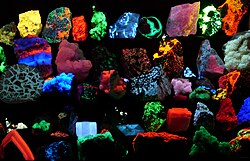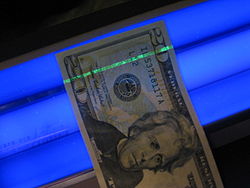Fluorescence

Fluorescence is the light given off by certain substances when it absorbs light or other electromagnetic radiation. First the substance absorbs the energy, then it emits light. When the light source is removed, the fluorescence stops occurring. It is a form of luminescence.
In most cases, the light given off has a longer wavelength and lower energy than the absorbed light.[1]
One of the most surprising types of fluorescence is when a substance absorbs ultraviolet light that cannot be seen by the human eye, but gives off visible light.
Fluorescence is used in many fields such as mineralogy, gemology, chemical sensors (fluorescence spectroscopy), dyes, biological detectors, and fluorescent lights.
Fluorescence in the life sciences is a way of tracking biological molecules. A protein or other component can have a fluorescent dye attached to it, which allows a scientist to visually find the specific protein with a microscope.[2]
Fluorescence Media
Fluorescent minerals emit visible light when exposed to ultraviolet.
Fluorescent clothes used in black light theater production, Prague
A cup made from the wood of the narra tree (Pterocarpus indicus) beside a flask containing its fluorescent solution Lignum nephriticum.
A ruby ball lens atop a green laser-pointer. The green beam converges into a cone within the crystal and is focused to a point on top. The green light is absorbed and spontaneously remitted as red light. Not all of the light is absorbed, and a small portion of the 520 nm laser light transmits through the top, unaltered by the ruby's red color.
Jablonski diagram. After an electron absorbs a high-energy photon the system is excited electronically and vibrationally. The system relaxes vibrationally, and eventually fluoresces at a longer wavelength than the original high-energy photon had.
The fluorescent dye, rhodamine 6G, is commonly used in applications such as highlighter pens, dye lasers, and automotive leak detection. The absorption profile is a mirror of the emission profile.
References
- ↑ Principles of instrumental analysis F.James Holler, Douglas A. Skoog & Stanley R. Crouch 2006
- ↑ Joseph R. Lakowicz (2006). Principles of fluorescence spectroscopy. Springer. p. xxvi. ISBN 978-0-387-31278-1. Retrieved 16 April 2011.









